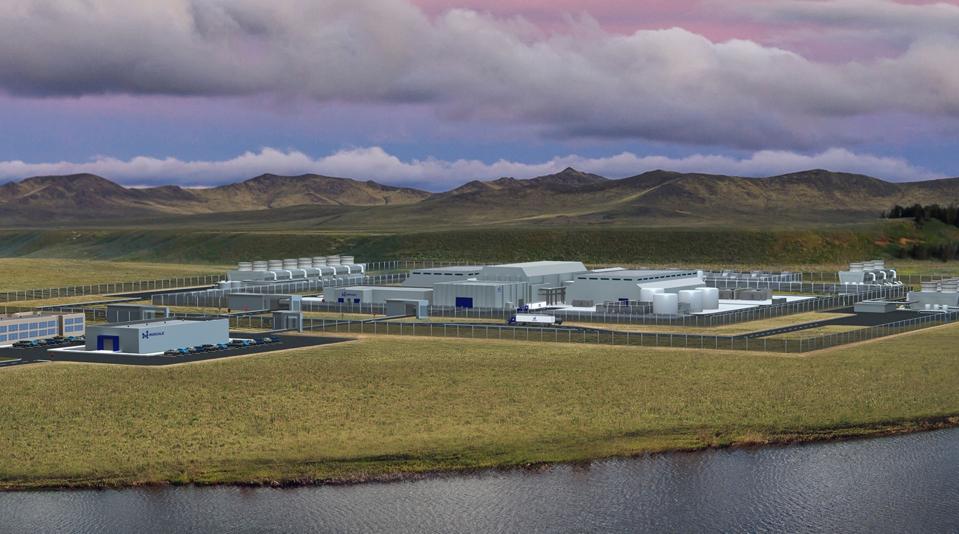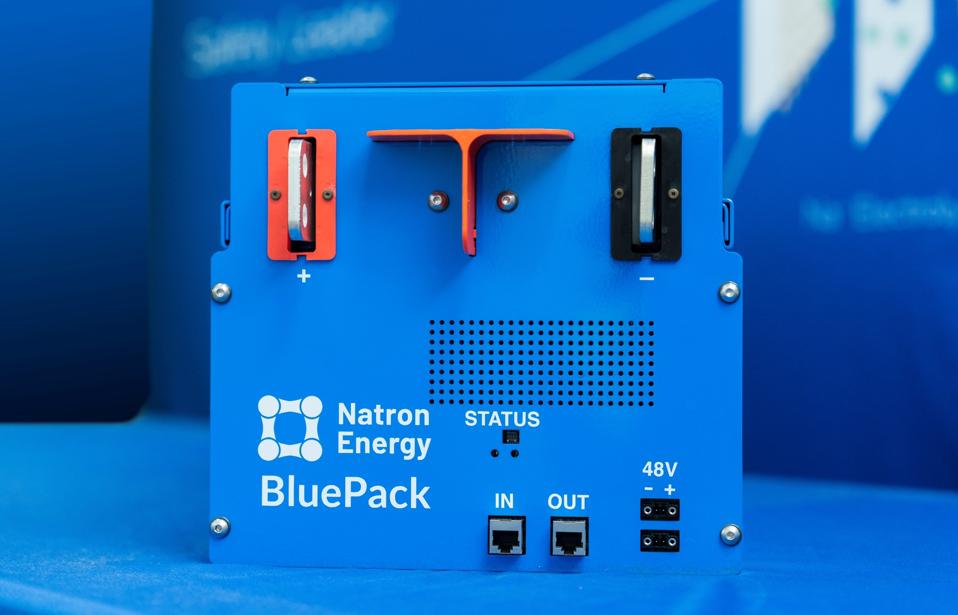Developers of new types of small nuclear reactors and battery chemistries are honing plans to profit by targeting data centers, which need more and more energy to fuel the AI boom.
This story featured in Issue 12 of Forbes Australia. Tap here to secure your copy.

For all the hype and billions of dollars swirling around AI, the only certainty is the grid-depleting amount of additional electricity needed to power the data centers running it. In that Clayton Scott sees a massive business opportunity.
“It’s a unique time and a unique situation,” Scott, chief commercial officer for NuScale Power, which is commercializing small-scale nuclear systems, told Forbes. “We landed in this unplanned, perfect match with the data world.”
A Goldman Sachs report, which sees AI applications triggering a 160% jump in overall data center power needs, estimated that ChatGPT queries need nearly 10 times as much electricity as Google searches. Pair that with the reality that the U.S. grid is at or near peak capacity relying on existing fossil-fuel plants — with a backlog of wind and solar renewable energy projects waiting to be connected to the grid in an effort to slash carbon emissions — and you’ve got the recipe for an energy crisis.
Scott hopes that NuScale Power provides one answer for data centers and their AI customers: each of its small modular nuclear reactors (SMRs) can generate 77 carbon-free megawatts continuously, which could allow them to operate independently of the grid entirely. The Portland-based startup, which went public in 2022 after over a decade of R&D, is working with data center developer Standard Power to supply 24 SMRs capable of collectively generating nearly 2 gigawatts of electricity – enough for a midsize city. (A report by a short-seller has questioned the validity of the deal.) It’s navigating the Nuclear Regulatory Commission’s lengthy review process and doesn’t expect to deploy reactors until late this decade. The company reported just $4.6 million in revenue in the first quarter and a loss of $56.4 million as it prepares for commercial deliveries.
“We landed in this unplanned, perfect match with the data world.”
Clayton Scott, NuScale Power
NuScale is one of many nuclear and battery startups aiming to capitalize on AI’s energy intensity. Typical data centers use about 32 megawatts of electricity, enough to power 6,000 homes, compared with about 80 megawatts for AI-oriented data centers, said Doug Vine, director of analysis at the Center for Climate and Energy Solutions, an environmental policy think tank in Arlington, Virginia. “And they need energy-dense systems, which, unfortunately, is why natural gas plants are still popular. But the same thing is true of nuclear power,” he said. “From a very small footprint, you can generate a lot of electricity.”

Nvidia’s H100 chip, loaded with eight GPUs and two CPUs, is the most in-demand AI server box for data centers, said Arman Shehabi, a Lawrence Berkeley Lab who’s tracked data center power demands since 2007. He estimates that each one uses eight to 10 kilowatts of electricity, versus previous servers, which would use a fraction of that. They generate so much heat that cooling them uses up to 30% more water than traditional data centers. Globally, AI demand may use up to 6.6 billion cubic meters of water in 2027, or “more than the total annual water withdrawal of Denmark or half of the United Kingdom,” according to a Cornell University study.
“They’re so heat dense and so power dense, they’re up in the range of 70 to 80 kilowatts per rack. And there’s talk that’s going to go up to 100 kilowatts really soon,” Shehabi said. “It’s basically 10 times higher than servers used in the past.”
Companies like Microsoft are also making plans to use SMRs to power their AI data centers, and company founder Bill Gates is chairman of TerraPower, which is developing a new kind of sodium reactor that also uses salt to store energy. OpenAI’s Sam Altman is backing Oklo, a developer of small fission reactors that recently went public, as well as Helion, one of many startups attempting to commercialize nuclear fusion, a compelling carbon-free power source that’s free of problematic nuclear waste. Still, it’s unlikely any fusion-based systems will become commercially viable until the 2030s.
Microreactors
SMRs aren’t the only nuclear option. Smaller microreactors like those developed by Radiant Nuclear can be used to replace dirty diesel backup generators or provide data centers with a little extra energy boost as needed. The Los Angeles-based company plans to sell 1-megawatt units that can be shipped directly from a factory by truck or airplane.

“They arrive in a single container and can just be set up and turned on,” CEO Doug Bernauer told Forbes. “That means if you suddenly needed a little bit of extra power at a data center, you could do that. Or if you wanted to set up a data center on the edge or in a microgrid, it may be very suitable for that. It takes just a couple of days to set up a unit and bring it up to full power.”
Radiant has raised $60 million of venture capital, led by Andreessen Horowitz, and wants to start delivering commercial units late this decade – assuming testing at Idaho National Laboratory goes well.
While nuclear power systems create no carbon emissions and are increasingly seen as a necessary component of a net-zero energy system, they still have a long-term challenge of safely storing spent radioactive fuel rods and other dangerous materials. Some companies are trying stationary fuel cells powered by carbon-free green hydrogen, though the supply of that clean fuel may not be cheap and plentiful for several years.
“If you wanted to set up a data center on the edge or in a microgrid, it may be very suitable for that.”
Doug Bernauer, Radiant Nuclear CEO
Another potential source is geothermal energy systems, being developed by startups like Fervo. Late last year, Google began testing Fervo’s system – it uses a horizontal drilling technique to tap into underground geothermal reservoirs of hot water to power generators – in Nevada that may be used for a data center.
Sodium Batteries
Regardless of what type of energy data centers are using, Colin Wessells, cofounder and co-CEO of Natron Energy, has created a new type of battery that is uniquely suited to one of the particularities of AI data centers: GPU chips can demand sudden surges of power. It’s “like a heartbeat,” Wessells told Forbes. “And that can cause stability issues for the grid.”
Natron Energy is among the first companies to begin selling sodium-ion batteries, which are well-suited to smoothing out those surges in power when AI servers “overclock” their standard compute speed. They act like a buffer that can smooth out the distribution of electricity to prevent overloads, “shaving the peak” off those surges. “We’re doing real-time energy management to support the compute as opposed to being just backup power.”
Sodium batteries have other benefits too: they can be recharged frequently without the kind of degradation that limits the life of lithium cells and, importantly, don’t catch on fire. Instead of holding electricity for a long time like the lithium-ion batteries in your electronics, they’re better at recharging quickly and shooting out power far more rapidly. “We’re driving a race car, not a Prius,” Wessells said. “We don’t have the range but we’ve got crazy speed.”
“We’re driving a race car, not a Prius. We don’t have the range but we’ve got crazy speed.”
Colin Wessells, Natron Energy co-CEO
Wessells now expects a major portion of the Santa Clara, California, startup’s initial revenue to come from data centers catering to AI applications. It’s shipping commercial units from a pilot line in Santa Clara and in a few months begins deliveries from a new plant in Michigan that opened this year.

Even though his batteries use lower-cost raw materials than lithium-ion cells, namely iron and manganese, they aren’t cheaper yet because they’re a new technology and there’s not yet a large supply base making the anodes and cathodes they use. As the sodium battery market grows, that should change later in the decade. But because of the demand from data centers, initial customers aren’t particularly concerned about price at this point, Wessells said.
“We targeted data centers as our initial market in 2014, so it’s been a full 10 years that we’ve been designing the product for this use case,” he said. “For the longest time, it was challenging for investors to understand this. They were saying, ‘Why the hell aren’t you trying to build car batteries like every other battery company out there?’ Now it’s really flipped in the past year. The market is going crazy.”



